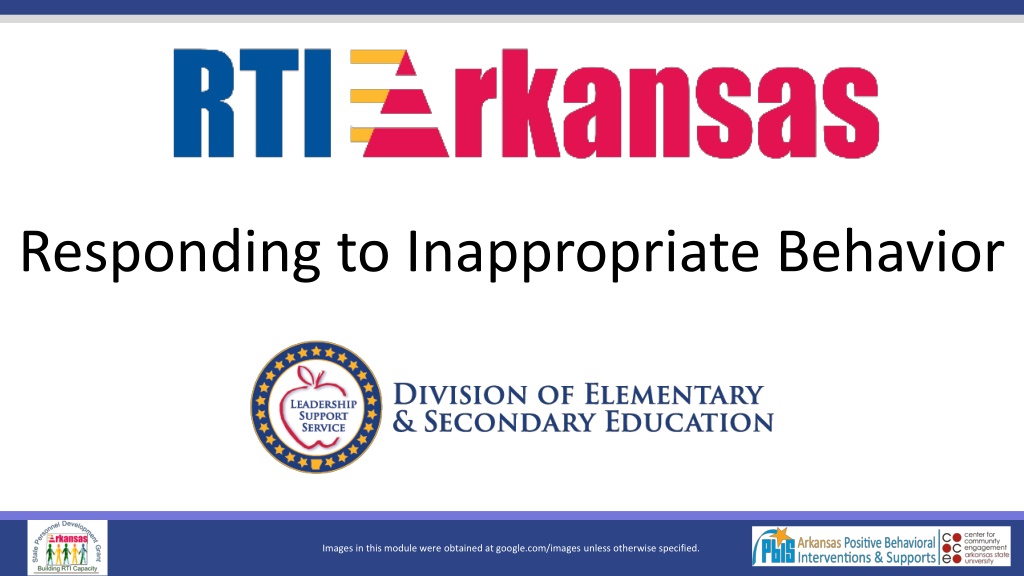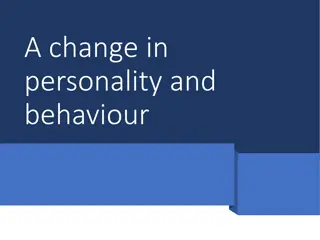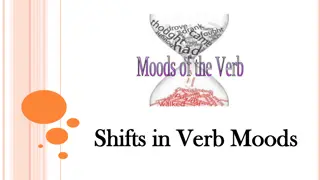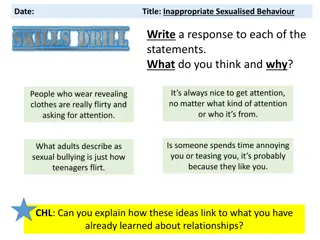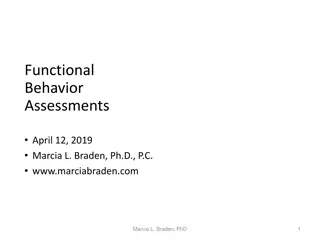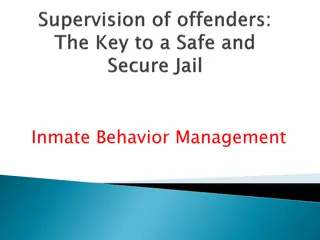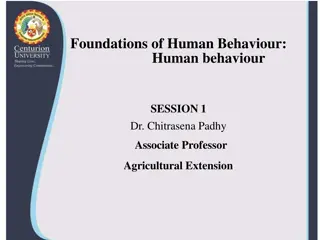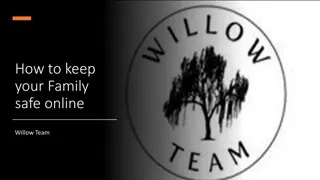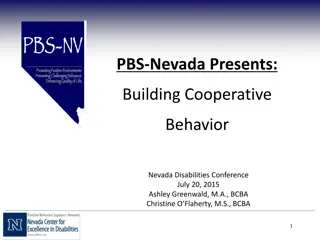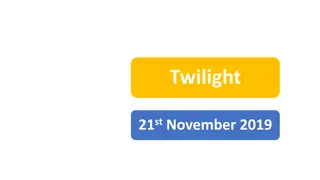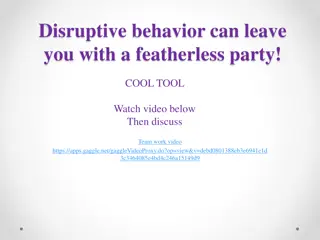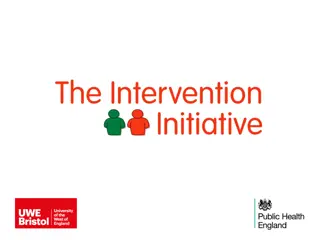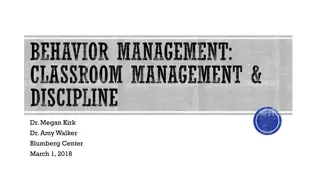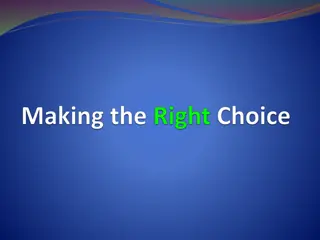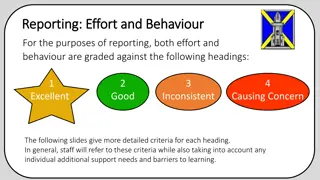Effective Strategies for Managing Inappropriate Behavior
Building on a proactive approach, this module discusses the importance of focusing on prevention and effective management techniques for inappropriate behavior in various settings. The content emphasizes the need for clear behavioral expectations, consistent teaching of desired behaviors, and the development of a system to address misbehavior through strategies like pre-correction and active supervision. By creating a predictable environment and viewing inappropriate behavior as a teaching opportunity, educators can effectively address and prevent such behaviors.
- Inappropriate Behavior
- Prevention Strategies
- Effective Management
- Positive Discipline
- Educational Practices
Download Presentation

Please find below an Image/Link to download the presentation.
The content on the website is provided AS IS for your information and personal use only. It may not be sold, licensed, or shared on other websites without obtaining consent from the author. Download presentation by click this link. If you encounter any issues during the download, it is possible that the publisher has removed the file from their server.
E N D
Presentation Transcript
Responding to Inappropriate Behavior Images in this module were obtained at google.com/images unless otherwise specified.
Context What isn t working with your current way of managing problem behaviors?
Ways That Dont Work Exclusion Punishing problem behavior without a positive, proactive, educative approach Punishment used alone interferes with teaching and learning.
What Does Work? Building on a current discipline policy (consequences) Developing a continuum of procedures for discouraging inappropriate behavior Focusing on teaching desired behaviors and when to appropriately use them (Lewis & Sugai, 1999)
Building A System To Manage Inappropriate Behavior Behaviors are defined and classified. Procedures and strategies are established to manage misbehavior. Behavior data are collected for effective decision making. The focus is on PREVENTION.
Prevention Is The Key Guiding Questions: Can we improve the physical environment or schedule? Do we have clear behavioral expectations? Have the expectations been thoroughly taught? Are we consistently using strategies to encourage the desired behaviors?
Prevention In The Classroom Start with prevention, not punishment. Active supervision (e.g., moving, scanning, prompting) Pre-correction Beginning of class period Transitions Moving to another setting
An Effective Approach Inappropriate behavior can become a teaching opportunity. Point out the problem (specific feedback) Re-teach Provide guided and unguided practice Provide follow-up feedback to indicate progress
Create A Predictable Environment Avoid reinforcing problem behavior. Provide effective strategies for responding to problem behavior. Differentiate office-managed and classroom-managed behaviors.
The Power Of Correcting Social Errors Through Teaching Upholds and demonstrates the importance of expectations Restores order to the learning environment Interrupts or prevents practice of inappropriate behavior Teachable moment: the learner is active, the learning is relevant Student learns to be successful Student learns valuable social skills Increases probability of future correct behavior Decreases future time out of learning/instruction Builds relationships with students Maintains a positive learning climate
Building Your Response System Determine how staff will efficiently and effectively respond to a range of inappropriate behavior. Minor behaviors Chronic minor behaviors Serious or dangerous behaviors
Staff-managed (Minor) Behaviors Use best practices (e.g., correction, re-teaching) Avoid escalation Anticipate students response Consider office referral for persistent behavior
Office-managed (Major) Behaviors Behavior that Is a serious or chronic disruption Concerns safety for the student or others Is potentially illegal Actions taken in the office may include More intensive teaching Restitution activities Strategies to help the student handle future situations Phone calls home
What Is Needed To effectively manage problem behavior, you must define all behaviors (be specific observable, measurable). define what constitutes office-managed behavior. document strategies to respond to minor behaviors. document procedures for responding to any misbehavior. develop related data gathering tools.
Example Of Behavior Definitions Minor Problem Behavior Definition Inappropriate verbal language Student engages in low intensity instance of inappropriate language (develop examples) Major Problem Behavior Definition Abusive language/ inappropriate language/ profanity Verbal messages that include swearing, name calling or use of words in an inappropriate way Make sure all staff have the definitions and report accurately.
Example (T-chart) Teacher managed behaviors (minor) Office managed behaviors (major) Tardy Chronic/severe bullying Stealing Vandalism Illegal substance Chronic non-compliance Possession of weapons Profanity directed at person Repeated disruptions Fighting/assault Threat Chronic class skipping Gang-related behaviors Sexual harassment False fire alarm/bomb threat Inappropriate language (minor) Chewing gum; food/drinks Not having materials/supplies Missing homework Tattling Teasing/bullying Lying Cheating Minor dress code violation Minor disruption Defiance/disrespect/non-compliance
Procedural Flow Charts Documents the standard procedure for responding to any inappropriate behavior All staff give input and come to a consensus Distribute final document to all staff to keep for reference
Purpose Of Office Discipline Referrals (ODRs) Interrupt problem behavior and prevent escalation Teach what is acceptable behavior Keep behavior from being rewarded Allow instruction to safely continue for others Collect data
Must-have Data For ODR Forms Student name Referring staff name Date of incident Time of incident Inappropriate behavior with designation of office- managed or staff-managed Location of incident Others involved Possible motivation Administrative decision
Guidelines For Office Referrals Ensure referral is appropriate use outlined procedures Complete ODR fully these are data points Be prepared to talk to your administrator to determine consequences. Make student s return to class a smooth transition
Guiding Questions 1. Is there consensus among staff on the definitions of all problem behaviors? 2. What are the minor problem behaviors in your school? 3. What are the major problem behaviors in your school? 4. Do you have a T-chart to distinguish minor from major behaviors? 5. What will you do when there are repeated minor behaviors?
Some Strategies For Minor Behaviors Re-teach expectations/rules Change seating arrangements Conference Peer mediation Student contracts Provide choices Remove tempting items from room Teach replacement skills Cool-off time Re-direction Restitution/apology Prompt Reward alternate positive behaviors Reward peers for using appropriate behaviors
Considerations For Correcting Misbehavior Be consistent Use least intrusive strategy Be specific, but brief Have a quiet, respectful interaction Refocus class first, if you will require a bit of time 26
Appropriate Consequences Matched to the severity of the behavior Matched to the perceived function of the behavior Should not result in a power struggle
Effective Consequences Result in greater learning Often involve learning tasks or opportunities Practice replacement behavior/skill Student demonstrates desired skill Make amends to others affected Invite student to take responsibility & also be part of solution Require effort and leave little incentive for repeat of misbehavior
Do It With Fidelity! Tiered Fidelity Inventory (TFI) Efficient, valid index of extent to which PBIS core features are in place Section 1.5 Problem Behavior Definitions Section 1.6 Discipline Policies
1.5 Problem Behavior Definitions Subscale: Implementation Scoring Criteria 0 = Not implemented 1 = Partially implemented 2 = Fully implemented 0 = No clear definitions exist, and procedures to manage problems are not clearly documented. Feature Data Sources Staff handbook Student handbook School policy Discipline flowchart 1.5 Problem Behavior Definitions: School has clear definitions for behaviors that interfere with academic and social success and a clear policy/procedure (e.g., flowchart) for addressing office-managed versus staff- managed problems. 1 = Definitions and procedures exist but are not clear and/or not organized by staff- versus office-managed problems. Main Idea: Operational definitions of problem behavior and consistent processes for responding to problem behavior improve the predictability of social expectations in the school. Focus on reducing reward for problem behavior. 2 = Definitions and procedures for managing problems are clearly defined, documented, trained, and shared with families.
1.6 Discipline Policies Subscale: Implementation Scoring Criteria 0 = Not implemented 1 = Partially implemented 2 = Fully implemented 0 = Documents contain only reactive and punitive consequences. Feature Data Sources Discipline policy Student handbook Code of conduct Informal administrator interview 1.6 Discipline Policies: School policies and procedures describe and emphasize proactive, instructive, and/or restorative approaches to student behavior that are implemented consistently. 1 = Documentation includes and emphasizes proactive approaches. 2 = Documentation includes and emphasizes proactive approaches AND administrator reports consistent use. Main Idea: Preventative and positive approaches to discipline are the most effective.
Summary Develop a continuum of procedures for responding to problem behavior. Be clear about behavior definitions and procedures. Make teaching a part of the response be proactive and prevent further escalation. Make sure responses are appropriate and consistent throughout the school.
Resources Missouri PBIS: http://pbismissouri.org/wp-content/uploads/2017/06/6.0- MO-SW-PBS-Tier-1-Workbook-Ch-6-Discouraging.pdf?x30198
